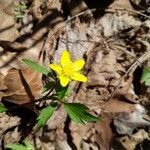Stems erect or ascending, never rooting nodally, strigose or spreading-strigose, base not bulbous. Roots always both filiform and tuberous on same stem. Basal leaf blades ovate to broadly ovate in outline, 3-5-foliolate, 2.1-4.7 × 1.9-4.5 cm, leaflets undivided or 1×-lobed or-parted, ultimate segments oblanceolate or obovate, margins entire or with few teeth, apex rounded-acute to rounded-obtuse. Flowers: receptacle hispid or glabrous; sepals spreading or sometimes reflexed from base, 5-7 × 2-3 mm, hispid or glabrous; petals 5(-7), yellow, 8-14 × 3-6 mm. Heads of achenes globose or ovoid, 5-9 × 5-8 mm; achenes 2-2.8 × 1.8-2.2 mm, glabrous, margin forming narrow rib 0.1-0.2 mm wide; beak persistent, filiform, straight, 1.2-2.8 mm. 2 n = 32.





